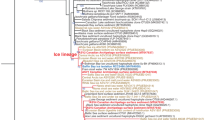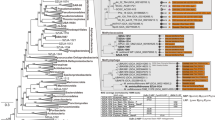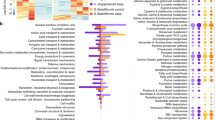Abstract
Cycloclasticus bacteria are ubiquitous in oil-rich regions of the ocean and are known for their ability to degrade polycyclic aromatic hydrocarbons (PAHs). In this study, we describe Cycloclasticus that have established a symbiosis with Bathymodiolus heckerae mussels and poecilosclerid sponges from asphalt-rich, deep-sea oil seeps at Campeche Knolls in the southern Gulf of Mexico. Genomic and transcriptomic analyses revealed that, in contrast to all previously known Cycloclasticus, the symbiotic Cycloclasticus appears to lack the genes needed for PAH degradation. Instead, these symbionts use propane and other short-chain alkanes such as ethane and butane as carbon and energy sources, thus expanding the limited range of substrates known to power chemosynthetic symbioses. Analyses of short-chain alkanes in the environment of the Campeche Knolls symbioses revealed that these are present at high concentrations (in the μM to mM range). Comparative genomic analyses revealed high similarities between the genes used by the symbiotic Cycloclasticus to degrade short-chain alkanes and those of free-living Cycloclasticus that bloomed during the Deepwater Horizon oil spill. Our results indicate that the metabolic versatility of bacteria within the Cycloclasticus clade is higher than previously assumed, and highlight the expanded role of these keystone species in the degradation of marine hydrocarbons.
This is a preview of subscription content, access via your institution
Access options
Access Nature and 54 other Nature Portfolio journals
Get Nature+, our best-value online-access subscription
$29.99 / 30 days
cancel any time
Subscribe to this journal
Receive 12 digital issues and online access to articles
$119.00 per year
only $9.92 per issue
Buy this article
- Purchase on Springer Link
- Instant access to full article PDF
Prices may be subject to local taxes which are calculated during checkout





Similar content being viewed by others
References
Bolin, B. in Oceanography (ed. Brewer, P. G. ) 305–326 (Springer, 1983).
Dando, P. R. & Hovland, M. Environmental effects of submarine seeping natural gas. Cont. Shelf Res. 12, 1197–1207 (1992).
Cicerone, R. J. & Oremland, R. Biogeological aspects of atmospheric methane. Global Biogeochem. Cycles 2, 229–327 (1988).
Collins, W. J., Derwent, R. G., Johnson, C. E. & Stevenson, D. S. The oxidation of organic compounds in the troposphere and their global warming potentials. Clim. Change 52, 453–479 (2002).
Katzenstein, A. S., Doezema, L. A., Simpson, I. J., Blake, D. R. & Rowland, F. S. Extensive regional atmospheric hydrocarbon pollution in the southwestern United States. Proc. Natl Acad. Sci. USA 100, 11975–11979 (2003).
Peterson, C. et al. Long-term ecosystem response to the Exxon Valdez oil spill. Science 302, 2082–2086 (2003).
Head, I. M. & Swannell, R. P. Bioremediation of petroleum hydrocarbon contaminants in marine habitats. Curr. Opin. Biotechnol. 10, 234–239 (1999).
Joye, S. B. et al. The Gulf of Mexico ecosystem, six years after the Macondo oil well blowout. Deep-Sea Res. II 129, 4–19 (2016).
Redmond, M. C. & Valentine, D. L. Natural gas and temperature structured a microbial community response to the Deepwater Horizon oil spill. Proc. Natl Acad. Sci. USA 109, 20292–20297 (2012).
Valentine, D. L. et al. Propane respiration jump-starts microbial response to a deep oil spill. Science 330, 208–211 (2010).
Kleindienst, S. et al. Diverse, rare microbial taxa responded to the Deepwater Horizon deep-sea hydrocarbon plume. ISME J. 10, 400–415 (2015).
Dombrowski, N. et al. Reconstructing metabolic pathways of hydrocarbon-degrading bacteria from the Deepwater Horizon oil spill. Nat. Microbiol. 1, 16057 (2016).
Hazen, T. C. et al. Deep-sea oil plume enriches indigenous oil-degrading bacteria. Science 330, 204–208 (2010).
Seo, J.-S., Keum, Y.-S. & Li, Q. X. Bacterial degradation of aromatic compounds. Int. J. Environ. Res. Public Health 6, 278–309 (2009).
Gutierrez, T. et al. Hydrocarbon-degrading bacteria enriched by the Deepwater Horizon oil spill identified by cultivation and DNA-SIP. ISME J. 7, 2091–2104 (2013).
Kappell, A. D. et al. The polycyclic aromatic hydrocarbon degradation potential of Gulf of Mexico native coastal microbial communities after the Deepwater Horizon oil spill. Front. Microbiol. 5, 205 (2014).
Kasai, Y., Kishira, H. & Harayama, S. Bacteria belonging to the genus Cycloclasticus play a primary role in the degradation of aromatic hydrocarbons released in a marine environment. Appl. Environ. Microbiol. 68, 5625–5633 (2002).
Yakimov, M. M., Timmis, K. N. & Golyshin, P. N. Obligate oil-degrading marine bacteria. Curr. Opin. Biotechnol. 18, 257–266 (2007).
Kasai, Y., Shindo, K., Harayama, S. & Misawa, N. Molecular characterization and substrate preference of a polycyclic aromatic hydrocarbon dioxygenase from Cycloclasticus sp. strain A5. Appl. Environ. Microbiol. 69, 6688–6697 (2003).
Dyksterhouse, S. E., Gray, J. P., Herwig, R. P., Lara, J. C. & Staley, J. T. Cycloclasticus pugetii gen. nov., sp. nov., an aromatic hydrocarbon-degrading bacterium from marine sediments. Int. J. Syst. Bacteriol. 45, 116–123 (1995).
Chung, W. K. & King, G. M. Isolation, characterization, and polyaromatic hydrocarbon degradation potential of aerobic bacteria from marine macrofaunal burrow sediments and description of Lutibacterium anuloederans gen. nov., sp. nov., and Cycloclasticus spirillensus sp. nov. Appl. Environ. Microbiol. 67, 5585–5592 (2001).
Cui, Z., Xu, G., Li, Q., Gao, W. & Zheng, L. Genome sequence of the pyrene- and fluoranthene-degrading bacterium Cycloclasticus sp. strain PY97M. Genome Announc. 1, e00536–13 (2013).
Messina, E. et al. Genome sequence of obligate marine polycyclic aromatic hydrocarbons-degrading bacterium Cycloclasticus sp. 78-ME, isolated from petroleum deposits of the sunken tanker Amoco Milford Haven, Mediterranean Sea. Mar. Genomics 25, 11–13 (2015).
MacDonald, I. R. et al. Asphalt volcanism and chemosynthetic life in the Campeche Knolls, Gulf of Mexico. Science 304, 999–1002 (2004).
Sahling, H. et al. Massive asphalt deposits, oil seepage, and gas venting support abundant chemosynthetic communities at the Campeche Knolls, southern Gulf of Mexico. Biogeosciences 13, 4491–4512 (2016).
Petersen, J. M., Wentrup, C., Verna, C., Knittel, K. & Dubilier, N. Origins and evolutionary flexibility of chemosynthetic symbionts from deep-sea animals. Biol. Bull. 223, 123–137 (2012).
Duperron, S. et al. Diversity, relative abundance and metabolic potential of bacterial endosymbionts in three Bathymodiolus mussel species from cold seeps in the Gulf of Mexico. Environ. Microbiol. 9, 1423–1438 (2007).
Raggi, L., Schubotz, F., Hinrichs, K.-U., Dubilier, N. & Petersen, J. M. Bacterial symbionts of Bathymodiolus mussels and Escarpia tubeworms from Chapopote, an asphalt seep in the Southern Gulf of Mexico. Environ. Microbiol. 15, 1969–1987 (2013).
Arellano, S. M. et al. Deep sequencing of Myxilla (Ectyomyxilla) methanophila, an epibiotic sponge on cold-seep tubeworms, reveals methylotrophic, thiotrophic, and putative hydrocarbon-degrading microbial associations. Microb. Ecol. 65, 450–461 (2013).
Li, M., Jain, S., Baker, B. J., Taylor, C. & Dick, G. J. Novel hydrocarbon monooxygenase genes in the metatranscriptome of a natural deep-sea hydrocarbon plume. Environ. Microbiol. 16, 60–71 (2014).
Tavormina, P. L., Ussler, W. & Orphan, V. J. Planktonic and sediment-associated aerobic methanotrophs in two seep systems along the North American Margin. Appl. Environ. Microbiol. 74, 3985–3995 (2008).
Hamamura, N., Yeager, C. M. & Arp, D. J. Two distinct monooxygenases for alkane oxidation in Nocardioides sp. strain CF8. Appl. Environ. Microbiol. 67, 4992–4998 (2001).
Coleman, N. V. et al. Hydrocarbon monooxygenase in Mycobacterium: recombinant expression of a member of the ammonia monooxygenase superfamily. ISME J. 6, 171–182 (2012).
Redmond, M. C., Valentine, D. L. & Sessions, A. L. Identification of novel methane-, ethane-, and propane-oxidizing bacteria at marine hydrocarbon seeps by stable isotope probing. Appl. Environ. Microbiol. 76, 6412–6422 (2010).
Suzuki, T., Nakamura, T. & Fuse, H. Isolation of two novel marine ethylene-assimilating bacteria, Haliea species ETY-M and ETY-NAG, containing particulate methane monooxygenase-like genes. Microbes Environ. 27, 54–60 (2012).
Rivers, A. R. et al. Transcriptional response of bathypelagic marine bacterioplankton to the Deepwater Horizon oil spill. ISME J. 7, 2315–2329 (2013).
Vangnai, A. S. & Arp, D. J. An inducible 1-butanol dehydrogenase, a quinohaemoprotein, is involved in the oxidation of butane by ‘Pseudomonas butanovora’. Microbiology 147, 745–756 (2001).
White, H., Huber, C., Feicht, R. & Simon, H. On a reversible molybdenum-containing aldehyde oxidoreductase from Clostridium formicoaceticum. Arch. Microbiol. 159, 244–249 (1993).
Vorobev, A. et al. Genomic and transcriptomic analyses of the facultative methanotroph Methylocystis sp. strain SB2 grown on methane or ethanol. Appl. Environ. Microbiol. 80, 3044–3052 (2014).
Matsen, J. B., Yang, S., Stein, L. Y., Beck, D. & Kalyuzhnaya, M. G. Global molecular analyses of methane metabolism in methanotrophic alphaproteobacterium, Methylosinus trichosporium OB3b. Part I: transcriptomic study. Front. Microbiol. 4, 40 (2013).
Schubotz, F. et al. Petroleum degradation and associated microbial signatures at the Chapopote asphalt volcano, Southern Gulf of Mexico. Geochim. Cosmochim. Acta 75, 4377–4398 (2011).
Joye, S. B., MacDonald, I. R., Leifer, I. & Asper, V. Magnitude and oxidation potential of hydrocarbon gases released from the BP oil well blowout. Nat. Geosci. 4, 160–164 (2011).
Head, I. M., Jones, D. M. & Röling, W. F. M. Marine microorganisms make a meal of oil. Nat. Rev. Microbiol. 4, 173–182 (2006).
Mendes, S. D. et al. Marine microbes rapidly adapt to consume ethane, propane, and butane within the dissolved hydrocarbon plume of a natural seep. J. Geophys. Res. Ocean. 120, 1937–1953 (2015).
Schubotz, F. Microbial Community Characterization and Carbon Turnover in Methane-Rich Marine Environments—Case Studies in the Gulf of Mexico and the Black Sea. PhD dissertation, Univ. Bremen (2009).
Gustafson, R. G., Turner, R. D., Lutz, R. A. & Vrijenhoek, R. C. A new genus and five new species of mussels (Bivalvia, Mytilidae) from deep-sea sulfide/hydrocarbon seeps in the Gulf of Mexico. Malacologia 40, 63–112 (1998).
Faure, B., Schaeffer, S. W. & Fisher, C. R. Species distribution and population connectivity of deep-sea mussels at hydrocarbon seeps in the Gulf of Mexico. PLoS ONE 10, e0118460 (2015).
Pape, T. et al. Molecular and isotopic partitioning of low-molecular-weight hydrocarbons during migration and gas hydrate precipitation in deposits of a high-flux seepage site. Chem. Geol. 269, 350–363 (2010).
Maruyama, A. et al. Dynamics of microbial populations and strong selection for Cycloclasticus pugetii following the Nakhodka oil spill. Microb. Ecol. 46, 442–453 (2003).
Zhou, J., Bruns, M. A. & Tiedje, J. M. DNA recovery from soils of diverse composition. Appl. Environ. Microbiol. 62, 316–322 (1996).
Peng, Y., Leung, H. C. M., Yiu, S. M. & Chin, F. Y. L. IDBA-UD: a de novo assembler for single-cell and metagenomic sequencing data with highly uneven depth. Bioinformatics 28, 1420–1428 (2012).
Seah, B. K. B. & Gruber-Vodicka, H. R. Gbtools: interactive visualization of metagenome Bins in R. Front. Microbiol. 6, 1451 (2015).
Albertsen, M. et al. Genome sequences of rare, uncultured bacteria obtained by differential coverage binning of multiple metagenomes. Nat. Biotechnol. 31, 533–538 (2013).
Nurk, S., Bankevich, A. & Antipov, D. Assembling genomes and mini-metagenomes from highly chimeric reads. Res. Comput. Mol. Biol. 10, 158–170 (2013).
Bankevich, A. et al. SPAdes: a new genome assembly algorithm and its applications to single-cell sequencing. J. Comput. Biol. 19, 455–477 (2012).
Gurevich, A., Saveliev, V., Vyahhi, N. & Tesler, G. QUAST: quality assessment tool for genome assemblies. Bioinformatics 29, 1072–1075 (2013).
Parks, D. H., Imelfort, M., Skennerton, C. T., Hugenholtz, P. & Tyson, G. W. CheckM : assessing the quality of microbial genomes recovered from isolates, single cells, and metagenomes. Genome Res. 25, 1043–1055 (2015).
Overbeek, R. et al. The SEED and the Rapid Annotation of microbial genomes using Subsystems Technology (RAST). Nucleic Acids Res. 42, D206–D214 (2014).
Huntemann, M. et al. The standard operating procedure of the DOE-JGI Microbial Genome Annotation Pipeline (MGAP v.4). Stand. Genomic Sci. 10, 86 (2015).
Johnson, M. et al. NCBI BLAST: a better web interface. Nucleic Acids Res. 36, W5–W9 (2008).
Goris, J. et al. DNA–DNA hybridization values and their relationship to whole-genome sequence similarities. Int. J. Syst. Evol. Microbiol. 57, 81–91 (2007).
Petkau, A., Stuart-Edwards, M., Stothard, P. & van Domselaar, G. Interactive microbial genome visualization with GView. Bioinformatics 26, 3125–3126 (2010).
Liao, Y., Smyth, G. K. & Shi, W. featureCounts: an efficient general purpose program for assigning sequence reads to genomic features. Bioinformatics 30, 923–930 (2014).
Robinson, M. D., McCarthy, D. J. & Smyth, G. K. edgeR: a Bioconductor package for differential expression analysis of digital gene expression data. Bioinformatics 26, 139–140 (2010).
Rocha, D. J. P., Santos, C. S. & Pacheco, L. G. C. Bacterial reference genes for gene expression studies by RT–qPCR: survey and analysis. Antonie Van Leeuwenhoek 108, 685–693 (2015).
Grabherr, M. G. et al. Full-length transcriptome assembly from RNA-Seq data without a reference genome. Nat. Biotechnol. 29, 644–652 (2011).
Camacho, C. et al. BLAST+: architecture and applications. BMC Bioinformatics 10, 421 (2009).
Wiśniewski, J. R., Zougman, A., Nagaraj, N. & Mann, M. Universal sample preparation method for proteome analysis. Nat. Methods 6, 359–362 (2009).
Hamann, E. et al. Environmental Breviatea harbour mutualistic Arcobacter epibionts. Nature 534, 254–258 (2016).
Petersen, J. M. et al. Chemosynthetic symbionts of marine invertebrate animals are capable of nitrogen fixation. Nat. Microbiol. 2, 16195 (2016).
Bettencourt, R. et al. High-throughput sequencing and analysis of the gill tissue transcriptome from the deep-sea hydrothermal vent mussel Bathymodiolus azoricus. BMC Genomics 11, 559 (2010).
Li, W. & Godzik, A. Cd-hit: A fast program for clustering and comparing large sets of protein or nucleotide sequences. Bioinformatics 22, 1658–1659 (2006).
Florens, L. et al. Analyzing chromatin remodeling complexes using shotgun proteomics and normalized spectral abundance factors. Methods 40, 303–311 (2006).
Swan, B. K. et al. Potential for chemolithoautotrophy among ubiquitous bacteria lineages in the dark ocean. Science 333, 1296–1300 (2011).
Le, S. Q. & Gascuel, O. An improved general amino acid replacement matrix. Mol. Biol. Evol. 25, 1307–1320 (2008).
Kimura, M. A simple method for estimating evolutionary rate of base substitutions through comparative studies of nucleotide sequences. J. Mol. Evol. 16, 111–120 (1980).
Kumar, S., Stecher, G. & Tamura, K. MEGA7: Molecular Evolutionary Genetics Analysis version 7.0 for bigger datasets. Mol. Biol. Evol. 33, 1870–1874 (2016).
Markowitz, V. M. et al. IMG 4 version of the integrated microbial genomes comparative analysis system. Nucleic Acids Res. 42, 560–567 (2014).
Vizcaíno, J. et al. Proteomexchange provides globally coordinated proteomics data submission and dissemination. Nat. Biotechnol. 32, 223–226 (2014).
Acknowledgements
The authors thank all who helped during the R/V Meteor research cruise M114, including onboard technical and scientific personnel, the captain and crew, and the ROV MARUM-QUEST 4000m team. The authors thank A. Crombie, University of East Anglia, UK, for discussions on propane metabolism and A. Rivers, DOE Joint Genome Institute, for sharing DWH plume PQQ-ADH transcript sequences. The authors thank M. Strous for access to proteomics equipment and E. Thorson for technical assistance with the determination of peptide concentrations. The purchase of the proteomics equipment was supported by a grant of the Canadian Foundation for Innovation to M. Strous. The authors acknowledge the Max Planck-Genome-Centre Cologne (http://mpgc.mpipz.mpg.de/home/) for generating the metagenomic and metatranscriptomic data used in this study. Cycloclasticus SAG sequencing was supported by the Joint Genome Institute's Community Science Program. The work conducted by the US Department of Energy Joint Genome Institute is supported by the Office of Science, Biological and Environmental Research Program of the US Department of Energy and by the University of California, Lawrence Berkeley National Laboratory under contract no. DE-AC02-05CH11231, Lawrence Livermore National Laboratory under contract no. DE-AC52-07NA27344 and Los Alamos National Laboratory under contract no. DE-AC02-06NA25396. The Campeche Knoll cruise was funded by the German Research Foundation (DFG, Deutsche Forschungsgemeinschaft). Additional support was provided through the MARUM DFG-Research Center/Excellence Cluster ‘The Ocean in the Earth System’ at the University of Bremen. The authors acknowledge the Mexican authorities for granting permission to conduct this research in the southern Gulf of Mexico (permission of DGOPA: 02540/14 from 5th November 2014). This study was funded by the Max Planck Society and the MARUM DFG-Research Center/Excellence Cluster ‘The Ocean in the Earth System’ at the University of Bremen. Further support was provided by an ERC Advanced Grant (BathyBiome, 340535) and a Gordon and Betty Moore Foundation Marine Microbial Initiative Investigator Award to N.D. (grant no. GBMF3811). D.L.V. and M.C.R. received funding from the US National Science Foundation grants OCE-1155855 and OCE-1046144. C.P.A. was supported by a postdoctoral fellowship from the Humboldt Foundation. M.K. was supported by a NSERC Banting Postdoctoral Fellowship.
Author information
Authors and Affiliations
Contributions
M.R.-B., C.B., C.P.A. and N.D. conceived the study. H.S. and G.B. provided the framework for deep-sea sample collections. M.R.-B. and C.B. processed the samples onboard. M.R.-B., C.P.A. and L.S. analysed the biological samples. M.K. prepared samples for proteomics, and generated, processed and analysed proteomic data. T.P. provided the short-chain alkane analyses. M.C.R. and D.L.V. collected, prepared and sequenced the samples for the Deepwater Horizon Cycloclasticus SAGs and MCR, and D.L.V., M.R.-B. and C.P.A. analysed their genomes. M.R.-B. and N.D. wrote the manuscript with contributions from all co-authors.
Corresponding authors
Ethics declarations
Competing interests
The authors declare no competing financial interests.
Supplementary information
Supplementary Information
Supplementary Notes, Supplementary Tables 1–8 and Supplementary Figures 1–9. (PDF 8018 kb)
Rights and permissions
About this article
Cite this article
Rubin-Blum, M., Antony, C., Borowski, C. et al. Short-chain alkanes fuel mussel and sponge Cycloclasticus symbionts from deep-sea gas and oil seeps. Nat Microbiol 2, 17093 (2017). https://doi.org/10.1038/nmicrobiol.2017.93
Received:
Accepted:
Published:
DOI: https://doi.org/10.1038/nmicrobiol.2017.93
This article is cited by
-
Bacterial aerobic methane cycling by the marine sponge-associated microbiome
Microbiome (2023)
-
Metabolic handoffs between multiple symbionts may benefit the deep-sea bathymodioline mussels
ISME Communications (2023)
-
Yam Seep at Four-Way Closure Ridge: a prominent active gas seep system at the accretionary wedge SW offshore Taiwan
International Journal of Earth Sciences (2023)
-
Recent Advances of Marine Sponge-Associated Microorganisms as a Source of Commercially Viable Natural Products
Marine Biotechnology (2022)
-
Characterizing the microbiomes of Antarctic sponges: a functional metagenomic approach
Scientific Reports (2020)



